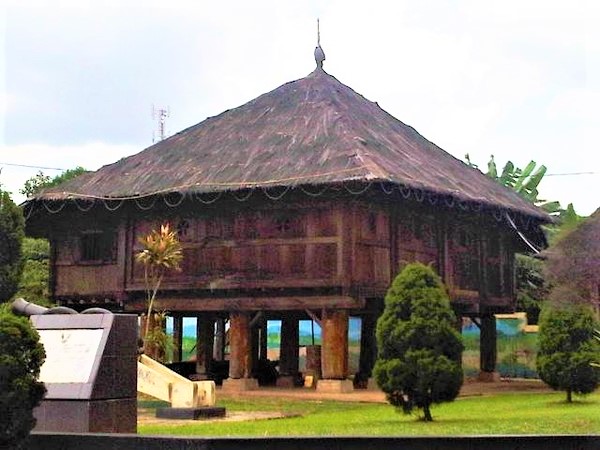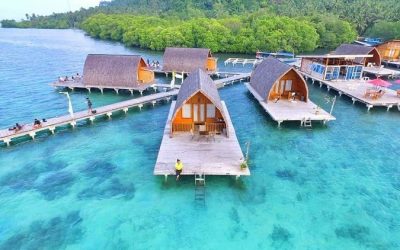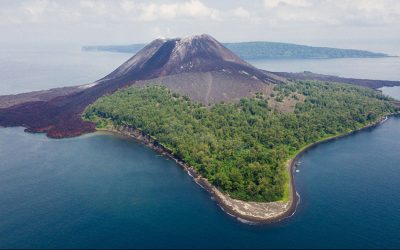Home / Batik Regions – Western Indonesia – Southern Sumatra – Lampung / Kenali Traditional Village
Cultural Destination
Embrace the spirit of the place!
Kenali Traditional Village

The Lampung traditional house, called Lamban Pesagi (photo: @travel.detik)
Kenali Traditional Village
Every region in Indonesia has a particular traditional house that represents the area, culture or the way the ancestors live for generations. In Lampung, the wooden traditional stage house is called Lamban Pesagi. The bottom part of the house serves as a place to save livestock and crops. Located in West Lampung, the Kenali Traditional Village is an instance of this tradition.
Tourist Attractions in Lampung
Pahawang Island
Pahawang Island has an amazing natural marine ecosystem. The island definitely has
Bandar Lampung City
It is the capital city in this region. Despite its congested town, it is full of
Krakatau Volcano
Krakatau remains one of the world most well-known volcanoes due to its
Lampung
Batik Motifs
Gamolan
This motif illustrates Gamolan, a bamboo musical instrument of Lampung that is
Pohon Hayat (Tree of Life)
The Batik motifs in Lampung are dominated by the acculturation of Buddhist and
Gajah Way Kambas
The motif illustrates the Lampung’s natural reserve, the Way Kambas. it also symbolizes
Mahkota Siger
Siger is the crown of a noblewoman in ancient time. It is a symbol of femininity, strength, and
Discover
Indonesian
Batik
Motifs
Kuda Kupang
Horses symbolize wealth. It contains noble values of virtuous characters that bring
Parang Seling
Parang Seling or “alternating daggers” is a royal batik motif. It is a feminine variant of
Pattimura
Pattimura is the name of an Indonesian hero who fought against colonialism in
Lontara
The Lontara script itself is a typical ancient script of Bugis and Makassar communities. History records that
Lipaq Sabe
Lipaq Saqbe contains a simple geometric classical motif with various flower decorations. This textile is
Singayaksa
The Singayaksa motif comes from the name of a place where Sultan Hasanuddin used to
Gentala Arasy
Built as high as 80 meters, the tower also highlights the historical side of
Srimanganti
The name of the Srimanganti motif is derived from Palace’s hallway that connects to
Lok Baintan Floating Market
As you can imagine, the most authentic thing is that you can buy things and even
Hiu Taliyasan
Indonesia is also home to the world’s largest fish, the whale shark (Rhincodon typus). Hiu Taliyasan refers to
Sandeq
Sandeq Boat is a symbol of the maritime importance of the West Sulawesi region. The greatness of
Pati-Pati Pinehiku
It symbolizes the hierarchy in society and the social status of the Mekongga
Tubo Kelapa
Coconut tree is a symbol of a good character and strong mentality. It illustrates the more success a person, the more
Daun Simpor
This motif is inspired by the Simpor plant (Dillenia Suffruticosa) which is a typical
Sekar Jati
Sekar means flower and Jati refers to teak trees that symbolizes a strong mental character that
Pohon Hayat (Tree of Life)
The Batik motifs in Lampung are dominated by the acculturation of Buddhist and
Bultiya
The word ‘Bultiya’ is an acronym of the three major tribes in North Kalimantan, namely
Tengkawang Ampiek
With its many advantages, the Dayaks use this leaf in ritual ceremonies. This plant is a symbol of
Gonggong Siput
Gonggong (Strombus Turturella) is one type of sea snail found around
Tikar Natuna
The Tikar Natuna motif is adapted from the traditional making of pandanus mats in
Tabir Tanjung
Tanjung flower is a type of Cherry tree flower, which is commonly found in
Salakanagara
Salakanagara batik motif illustrates the first kingdom in the Betawi land
Cengkeh
The clove flower motif is the main commodity of the Tolitoli Regency. This motif represents
Durian Pecah
Broken Durian motifs depict the foundation of faith. The second half signifies the mastery of
Tongkonan
Toraja’s traditional house is called Tongkonan. Tongkonan is a place for
Besurek Rembulan
This batik illustrates praise for God who created the wonderful universe
Honai
The Honai is inspired by the traditional house of the Papuan community living in
Sero Tangga
The Sero Tangga illustrates an endearing feeling and sacrifices of a person to fulfil
Besurek Rafflesia
The term “Basurek” refers to a textile that contains letters or inscriptions
Gamolan
This motif illustrates Gamolan, a bamboo musical instrument of Lampung that is
Gurdo Solo
Gurdo or garuda bird is the mount of the Indian god Vishnu. As the Sun Bird,
La Galigo
La Galigo is a literary work of the Buginese Epic that has 300 thousand epic lines. It is considered even
Kawung
The Kawung motif was created by Sultan Agung Hanyokrokusumo (1593 – 1645) as a symbolic gift for
Ake Patra
Ake is related to the divinity and the composition of the universe. It is a symbol of
Sido Mulyo
Sidomulyo is one of the classical motifs, which is specifically used for the bride’s costume in
Leuit Sijimat
This motif reflects the daily activities of the Baduy tribe in Banten. The main ornaments of batik motif consist of:
Kain Cual
Cual textile tradition has existed since the 17th century. The word “Cual” refers to
Rangkiang
The word “Rangkiang” refers to the rice granary in the Minangkabau language. It symbolizes
Gumin Tambun
Based on Hindu mythology, this motif symbolizes lucks, abundant wealth, and
Biji Kopi
The coffee seeds motif illustrates the pride of local coffee specialities in
Bintik Tujuh
The Bintik Tujuh (Seven Dots) motif has 7 white spots and green color gradation as
Keluak Daun Pakis
The word “Keluak” is a Minang language which means twisted or tangled. The Motif of
Jumputan Bintang
The word Jumputan means the tie-dye technique, while the word “Bintang” refers to
Wirasat
Wirasat or divine inspiration is a gift from God. This inspiration is symbolized by
Dayak Taghol
Dayak Taghol has a distinctive style of four curved lines and small dots. This motif represents
Raja Ampat
Raja Ampat motif represents the marine life at Raja Ampat archipelago in
Gedhog Kembang Waluh
a combination of Javanese cultural motif of the Majapahit kingdom (XII-XIV century) with
Wakatobi
It symbolizes the coastal beauty of the Wakatobi island and the symbol of Patra symbolizes
Daun Sirih
This motif illustrates betel leaves that are used by Lombok communities as traditional
Kaharingan
The Kaharingan or ‘tree of life’ based on the Dayak tribes’ belief system. This tree symbolizes
Teguh Bersatu
This batik motif shows the strength of the people of Kupang. It also represents a sense of
Gonggong Beruntun
This motif illustrates that a person should maintain a positive attitude and
Kasih Tak Sampai
‘Kasih Tak Sampai’ is an idiom in the Indonesian language which refers to
Jupri Kembang Teh
Kembang Teh illustrates the tendrils of tea plants that grow in the highlands of
Buketan Bali
The Balinese bouquet (Buketan Bali) is a floral arrangement and the name is
Karawo Pinang
Pinang refers to the Palm areca tree. This motif is considered as the original
Pinawetengan
The Pinawetengan Batik pattern was taken from a prehistoric inscription in
Kerawang Tegak Aceh
The Vertical Upright (Kerawang Tegak) Motif symbolizes a person who has a strong
Merak Ngeram
The hatching peacock motif has a very deep meaning which refers to the sacrifice and
Bomba Mawar
This motif means sacred love for family, kingdom, and God; It also illustrates
Kaganga Tanah Rejang
If Batik Besurek combines Arabic calligraphy motifs, then the Kaganga batik takes
Burung Bidadari
Bidadari birds are endemic birds in Halmahera. This motif represents an
Parang Rusak
Another meaning behind this motif is an unconquerable spirit, symbolized by
Manguni Minahasa
Manguni is identified as the symbol of the Minahasa people. Manguni is known as a
Tifa Totobuang
The batik motifs illustrate Maluku’s traditional music instrument called
Pucuk Rebung Riau
Pucuk Rebung symbolizes heart determination in achieving goals, good luck, and
Pala Salawaku
This motif illustrates the unique weapons of the Maluku region, namely
Tanah Liek
The word “Tanah Liek” refers to clay in Minang language. It is also known as
Paqbarre Allo
The word “Barre” means round and “Allo” means the sunlight. This motif is interpreted as
Gorga Simeol-Meol
The Gorga Simeol-meol is a pattern of plant tendrils. it is regarded as a symbol of longevity and
Desa Na Tolu
The Desa Na Tolu characteristic pattern symbolizes the Batak philosophy of existence and
Sekomandi
Its philosophical meaning is the eternal union which refers to a saying “until death do us part”



